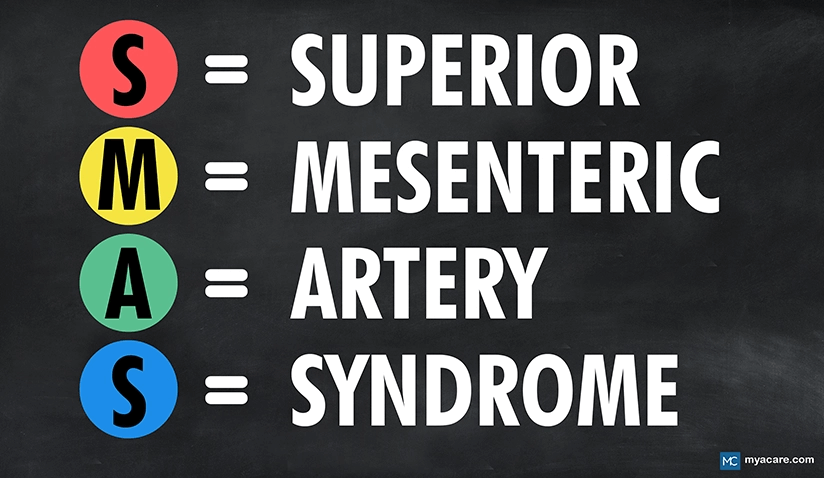Superior Mesenteric Artery Syndrome (SMAS): Symptoms, Causes, Treatment, and More

Medically Reviewed by Dr. Rae Osborn Ph.D. - June 28, 2024
Superior Mesenteric Artery Syndrome (SMAS) is a rare and possibly life-threatening ailment that affects the digestive system, causing it to become backed up and overburdened.
This article explores what SMAS is, its symptoms, causes, diagnosis, and treatment options.
What is Superior Mesenteric Artery Syndrome?
Superior Mesenteric Artery Syndrome is a condition that affects the digestive system. It arises in response to digestive compression when the third portion of the duodenum (the first part of the small intestine) gets trapped between the superior mesenteric artery (SMA) and the abdominal aorta, leading to a blockage in the flow of food and fluids[1]. This compression can cause severe digestive issues and can even be life-threatening if left untreated.
SMAS is a rare condition, with an estimated occurrence of 0.1% to 0.3% around the globe[2]. It is more commonly seen in females, with a female-to-male ratio of 3:2. The condition is most commonly diagnosable in young adults, with a peak incidence between the ages of 10 and 39.
Other names for Superior Mesenteric Artery Syndrome include:
- Wilkie syndrome
- Cast syndrome
- Chronic duodenal ileus
- Arterio-mesenteric duodenal compression syndrome
SMAS Symptoms
The symptoms of SMAS can vary from person to person, be gradual or sudden, and they may also change over time.
Some common symptoms include[3]:
- Severe abdominal pain, especially after eating
- Nausea and vomiting
- Bloating and distention of the abdomen
- Weight loss
- Difficulty swallowing
- Acid reflux
- Early satiety (feeling full after consuming small amounts of food)
- Malnutrition and dehydration
What is Nutcracker Syndrome?
Nutcracker Syndrome[4] occurs when the left renal vein is squeezed between the aorta and superior mesenteric artery. While SMA and nutcracker syndrome have similar underlying causes, their co-occurrence is uncommon.
What is the Difference Between Superior Mesenteric Artery Syndrome and Nutcracker Syndrome?
Although both Nutcracker syndrome and superior mesenteric artery syndrome involve the SMA, they are not the same. The former arises from left renal vein compression between the aorta and the SMA, whereas the latter is caused by the compression of the duodenum between the SMA and the aorta. Nutcracker syndrome can cause left flank and pelvic pain and blood in the urine, but the symptoms may not be present in everyone.
Causes and Risk Factors
Duodenal compression results from a loss of the mesenteric fat pad between the aorta and SMA, which narrows the angle between the vessels. A normal aorto-mesenteric angle is 38-65 degrees; a decrease below 25 degrees can compress the duodenum.
Causes of this compression can be congenital or acquired. In congenital cases, a birth defect such as spinal or growth abnormalities may lead to compression of the duodenum, demanding surgical correction.
Other factors that can increase the risk of contracting SMAS are:
- Rapid weight loss: This can cause a decrease in the amount of fat surrounding the SMA, making it more likely to compress the duodenum. Severe malabsorption, cachexia, anorexia nervosa, severe burn wounds, and advanced heart failure can lead to rapid weight loss-induced SMAS.
- Prolonged bed rest: Certain body positions, such as lying flat on the back, can increase the pressure on the duodenum and worsen the compression.
- Abdominal surgery: Previous abdominal surgeries, such as spinal fusion or gastric bypass, can alter the anatomy and increase the risk of SMAS. Scoliosis surgery may also result in SMAS.
- Trauma: In rare cases, trauma to the abdomen can cause damage to the SMA, leading to SMAS.
- Lordosis: An increased curvature in the lumbar portion of the spine can contribute to SMAS by altering the position of the abdominal organs and potentially increasing the pressure on the duodenum, leading to compression.
Complications
Receiving a timely diagnosis and starting treatment are crucial. If SMAS goes untreated, it can lead to severe complications, such as:
- Malnutrition and dehydration
- Bowel obstruction
- Perforation of the duodenum
- Sepsis (a life-threatening infection)
- Fatality
Superior Mesenteric Artery Syndrome Diagnosis
Diagnosing SMAS can be challenging, as the symptoms can seem generic[5], overlapping with several other digestive conditions.
A complete medical history and examination can imply a digestive disorder like SMAS. Imaging tests, such as an upper gastrointestinal (GI) series or a CT scan, are usually necessary to rule out other conditions and confirm the diagnosis. These can help visualize the compression of the duodenum and confirm the diagnosis of SMAS.
Conditions with similar symptoms to SMAS include[6]:
- Peptic ulcer disease
- Gallbladder disease (gallstone disease or biliary dyskinesia)
- Irritable bowel disease
- Inflammation of the duodenum (duodenitis)
- Visceral neuropathy
- Cyclic vomiting syndrome
- Inflammation of the pancreas (pancreatitis)
- Disorders causing duodenal dysmotility, like diabetes and chronic mesenteric ischemia
- Median arcuate ligament syndrome (MALS) or celiac steal syndrome
- Gastroparesis, especially in chronic SMA syndrome
Treatment Options for SMAS
The treatment for SMAS depends on the condition’s severity and the individual's overall health. In some cases, conservative management may sufficiently relieve symptoms, while others may require surgery.
Conservative Management
The primary treatment for SMAS is typically conservation, involving nutritional interventions such as:
- Parenteral nutrition: This intervention involves receiving nutrients through an IV, bypassing the digestive system.
- Gastric decompression: A tube enters the stomach through the nose or mouth to remove excess air and fluid.
- Fluid resuscitation: Intravenous fluids can prevent dehydration and offer additional nutrients to aid in the absorption of food.
- Electrolyte correction: Electrolytes, such as sodium and potassium, may need to be replaced to maintain proper balance in the body.
- Posture therapy: Changing body positions, such as lying on the left side or sitting up, can help relieve symptoms.
Individuals with SMAS can benefit from consuming smaller, more frequent meals, avoiding trigger foods, and receiving nutritional guidance to address malnutrition and avoid the risk of duodenal compression. In some cases, supplementation may be of benefit. These interventions aim to improve weight gain, reduce duodenal pressure, improve food passage, and maintain essential nutrient levels.
Surgery
Following stabilization with conservative management, patients who fail to respond tend to need surgery.
Surgical treatments include:
- Endoscopic Balloon Dilation: Endoscopic balloon dilation is a minimally invasive procedure. It involves the insertion of a tiny balloon into the duodenum and inflating it to widen the narrowed area. This process can help relieve the compression and improve the flow of food and fluids[7].
- Laparoscopic Duodenojejunostomy: Surgery may be necessary in severe cases of SMAS. Laparoscopic duodenojejunostomy is a minimally invasive surgical procedure that involves creating a bypass between the duodenum and the jejunum (the second part of the small intestine). This bypass allows food and fluids to bypass the compressed area and reach the rest of the digestive system.[8]
As with any surgery, there are risks associated with SMAS surgery, including:
- Infection
- Bleeding
- Blood clots
- Anesthesia complications
- Damage to surrounding organs
- Bowel obstruction
- Recurrence of SMAS
While everyone's recovery journey after SMAS surgery is different, it usually takes 4-6 weeks to fully recover. During this time, following the doctor's instructions and taking any prescribed medications to prevent complications is essential.
In some cases, SMAS can return after treatment, primarily if the underlying cause remains unaddressed. It is vital to adhere to a healthy diet plan and maintain a stable weight to prevent the recurrence of SMAS.
Collaboration with healthcare professionals ensures personalized care and effective management of SMAS symptoms.
How to Prevent SMAS?
While there is no guaranteed way to prevent SMAS, maintaining a healthy weight and avoiding rapid weight loss can help reduce the risk. It is also essential to seek medical attention if you experience any symptoms of SMAS, as early diagnosis and treatment can prevent complications.
Latest Advancements in Treatment
Advancements in surgical approaches have made treatment significantly less invasive and promote faster recovery.
One of the most significant breakthroughs is robot-assisted surgery. Robotic technology provides surgeons with enhanced precision and visualization during minimally invasive procedures. This technique holds great potential for further improving surgical outcomes and minimizing complications.[9]
Living with SMAS
Living with SMAS is a challenge until one receives optimal treatment. With proper treatment and management, it is possible to lead a healthy and fulfilling life.
It is crucial to follow a healthy diet, maintain a stable weight, and seek medical attention if any symptoms recur. Eating smaller, periodic meals can help reduce symptoms and stay well-hydrated.
There is no specific diet for SMAS. Your doctor might recommend avoiding foods that trigger discomfort or worsen your symptoms.
You may also benefit from consuming softer, easily digestible foods that promote weight gain,[10] coupled with regular muscle-building (weight-bearing) exercises. Foods should be tailored to your specific case and cater to other underlying health conditions. Work with your doctor or a dietician to achieve and maintain a healthy weight range.
Routine checkups are essential for keeping track of your condition and managing any potential issues that might arise.
Conclusion
Superior Mesenteric Artery Syndrome is a rare, life-threatening condition that affects the digestive system. Seeking medical attention if you experience any symptoms is essential, as swift detection and treatment can prevent complications and drastically improve outcomes. With technological advancements and refinements to surgical techniques, the treatment of SMAS is becoming more effective and less invasive, giving hope to those with this condition.
To search for the best doctors and healthcare providers worldwide, please use the Mya Care search engine.
The Mya Care Editorial Team comprises medical doctors and qualified professionals with a background in healthcare, dedicated to delivering trustworthy, evidence-based health content.
Our team draws on authoritative sources, including systematic reviews published in top-tier medical journals, the latest academic and professional books by renowned experts, and official guidelines from authoritative global health organizations. This rigorous process ensures every article reflects current medical standards and is regularly updated to include the latest healthcare insights.

Dr. Rae Osborn has a Ph.D. in Biology from the University of Texas at Arlington. She was a tenured Associate Professor of Biology at Northwestern State University, where she taught many courses to Pre-nursing and Pre-medical students. She has written extensively on medical conditions and healthy lifestyle topics, including nutrition. She is from South Africa but lived and taught in the United States for 18 years.
Sources:
Featured Blogs



